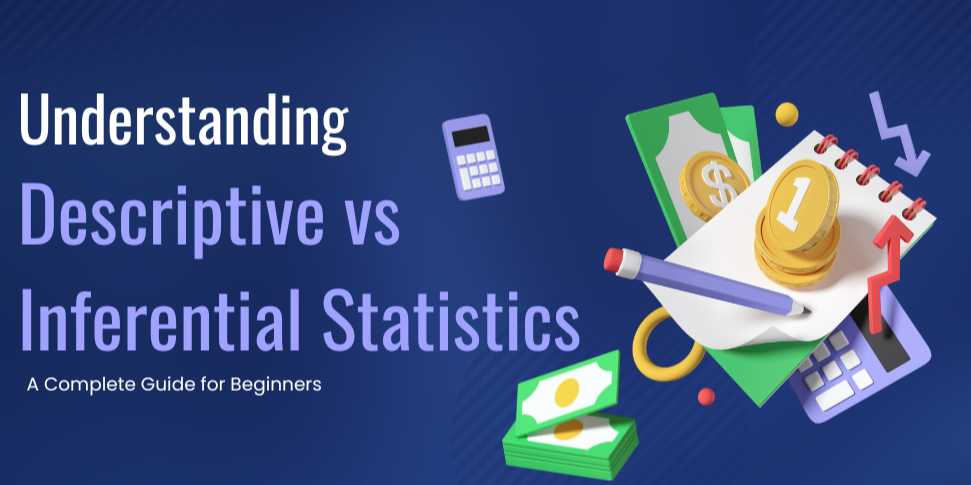Understanding Descriptive vs Inferential Statistics: A Complete Guide for Beginners

📗 Chapter 1: Introduction to Statistics and Its Branches
Understand the Fundamentals of Statistics and Its Two
Core Branches: Descriptive & Inferential
🧠 Introduction
In today's data-driven world, statistics plays a
critical role in how we make decisions — from healthcare diagnostics and
political forecasting to marketing strategies and scientific discoveries.
Whether you're a student, analyst, entrepreneur, or researcher, a strong
grasp of statistical thinking is essential for turning raw data into
meaningful insights.
But before diving into complex models and formulas, it’s
crucial to start with the basics: What is statistics? And more
importantly — how do descriptive and inferential statistics work together to
help us understand and use data?
In this chapter, we’ll explore:
- What
statistics is and why it matters
- The
types of data and variables
- The
two main branches of statistics
- Real-world
examples of how each branch is used
- Foundational
concepts that set the stage for deeper statistical learning
📘 Section 1: What Is
Statistics?
📌 Definition:
Statistics is the science of collecting, organizing,
analyzing, interpreting, and presenting data.
It's used to:
- Summarize
information (descriptive)
- Make
predictions or decisions under uncertainty (inferential)
🔍 Real-World Relevance:
|
Domain |
Statistical
Application |
|
Healthcare |
Identifying treatment
effectiveness |
|
Business |
Analyzing
customer behavior and trends |
|
Sports |
Measuring athlete
performance |
|
Government |
Conducting
population censuses & policy design |
|
Education |
Evaluating student
performance patterns |
📘 Section 2: Types of
Data in Statistics
Before diving into analysis, it’s essential to understand what
type of data you're working with.
1. Quantitative Data
Numerical values that can be measured.
|
Type |
Example |
|
Discrete |
Number of children,
goals scored |
|
Continuous |
Height,
weight, income |
2. Qualitative (Categorical) Data
Descriptive values (labels) that classify data.
|
Type |
Example |
|
Nominal |
Gender, color, city
name |
|
Ordinal |
Rating scales
(low, medium, high) |
🧪 Code Example: Checking
Data Types with Python
python
import
pandas as pd
data
= {
'Name': ['Alice', 'Bob', 'Charlie'],
'Age': [23, 35, 45],
'Gender': ['F', 'M', 'M'],
'Satisfaction': ['High', 'Medium', 'Low']
}
df
= pd.DataFrame(data)
print(df.dtypes)
📘 Section 3: Branches of
Statistics
🔹 A. Descriptive
Statistics
Descriptive statistics is all about summarizing or describing
the characteristics of a dataset.
Key Components:
- Measures
of Central Tendency: Mean, Median, Mode
- Measures
of Dispersion: Range, Variance, Standard Deviation
- Data
Visualization: Histograms, Pie Charts, Box Plots
Example:
You collect test scores of 100 students and calculate:
- Average
= 72
- Median
= 75
- Range
= 55 to 98
You're using descriptive statistics.
🔹 B. Inferential
Statistics
Inferential statistics helps you draw conclusions or make
predictions about a population based on a sample.
Key Components:
- Estimation:
Confidence Intervals
- Hypothesis
Testing: t-test, ANOVA, Chi-Square
- Regression
and Correlation: Predict relationships
Example:
You survey 200 customers and find that 65% are satisfied.
You infer that ~65% of all your customers are likely satisfied.
📘 Section 4: Comparison
Table – Descriptive vs. Inferential
|
Feature |
Descriptive
Statistics |
Inferential
Statistics |
|
Purpose |
Summarize data |
Make generalizations |
|
Scope |
Entire
dataset |
Sample used
to predict about population |
|
Tools |
Mean, median, charts |
t-tests, regression,
confidence intervals |
|
Output |
Exact values |
Probabilities,
estimates |
|
Application |
Overview of current
data |
Decision-making,
forecasting |
📘 Section 5: Real-Life
Scenarios
|
Scenario |
Branch Used |
|
A dashboard shows
average monthly sales per region |
Descriptive |
|
A/B testing a new product layout to see which performs better |
Inferential |
|
Measuring average
temperature across 12 months |
Descriptive |
|
Predicting next quarter’s revenue based on a sample survey |
Inferential |
|
Summarizing survey
responses with bar charts |
Descriptive |
📘 Section 6: Common
Statistical Terms
|
Term |
Meaning |
|
Population |
Entire group being
studied (e.g., all voters) |
|
Sample |
Subset of the
population (e.g., 1,000 voters surveyed) |
|
Parameter |
A measure describing
the population (e.g., true mean age) |
|
Statistic |
A measure
describing a sample (e.g., sample mean) |
|
Variable |
A characteristic that
can vary (e.g., income, age, gender) |
🧠 Code Example:
Descriptive Stats with Pandas
python
import
seaborn as sns
df
= sns.load_dataset("tips")
#
Summary statistics
print(df.describe())
#
Mean of total bill by day
print(df.groupby('day')['total_bill'].mean())
#
Histogram
df['total_bill'].hist(bins=20)
📘 Section 7: Why Both
Branches Matter
Descriptive statistics provides the foundation to
explore and understand your data.
Inferential statistics takes your findings a step further —
helping you make educated guesses, test theories, and drive decisions
when working with incomplete information.
They are not competing approaches — they are
complementary.
📘 Summary Table: Chapter
Takeaways
|
Topic |
Summary |
|
Statistics |
The science of
analyzing data to gain insight |
|
Data Types |
Quantitative
vs. Qualitative |
|
Descriptive
Statistics |
Describes and
visualizes data |
|
Inferential Statistics |
Makes
predictions from samples |
|
Real-world Use |
Used across
healthcare, business, government, research |
FAQs
1. What is the main difference between descriptive and inferential statistics?
Answer: Descriptive statistics summarize and describe the features of a dataset (like averages and charts), while inferential statistics use a sample to draw conclusions or make predictions about a larger population.
2. Do I need both descriptive and inferential statistics in a data analysis project?
Answer: Yes, typically. Descriptive stats help explore and understand the data, and inferential stats help make decisions or predictions based on that data.
3. Can I use descriptive statistics on a population?
Answer: Absolutely. Descriptive statistics can be used on either a full population or a sample — they simply describe the data you have.
4. Why do we use inferential statistics instead of just analyzing the whole population?
Answer: It’s often impractical, costly, or impossible to collect data on an entire population. Inferential statistics allow us to make reasonable estimates or test hypotheses using smaller samples.
5. What are examples of descriptive statistics?
Answer: Common examples include the mean, median, mode, range, standard deviation, histograms, and pie charts — all of which describe the shape and spread of the data.
6. What are common inferential statistical methods?
Answer: These include confidence intervals, hypothesis testing (e.g., t-tests, chi-square tests), ANOVA, and regression analysis.
7. Is a confidence interval descriptive or inferential?
Answer: A confidence interval is an inferential statistic because it estimates a population parameter based on a sample.
8. Are p-values part of descriptive or inferential statistics?
Answer: P-values are part of inferential statistics. They are used in hypothesis testing to assess the evidence against a null hypothesis.
9. How do I know when to stop with descriptive statistics and move to inferential?
Answer: Once you've summarized your data and understand its structure, you'll move to inferential statistics if your goal is to generalize, compare groups, or test relationships beyond your dataset.
10. Can visualizations be used in inferential statistics?
Answer: Yes — while charts are often associated with descriptive stats, inferential techniques can also be visualized (e.g., confidence interval plots, regression lines, distribution curves from hypothesis tests).
Tutorials are for educational purposes only, with no guarantees of comprehensiveness or error-free content; TuteeHUB disclaims liability for outcomes from reliance on the materials, recommending verification with official sources for critical applications.
Explore Other Libraries
Please allow ads on our site
Kindly log in to use this feature. We’ll take you to the login page automatically.
Login
Join Our Community Today
Ready to take your education and career to the next level? Register today and join our growing community of learners and professionals.

Your experience on this site will be improved by allowing cookies. Read Cookie Policy
Your experience on this site will be improved by allowing cookies. Read Cookie Policy

Comments(0)